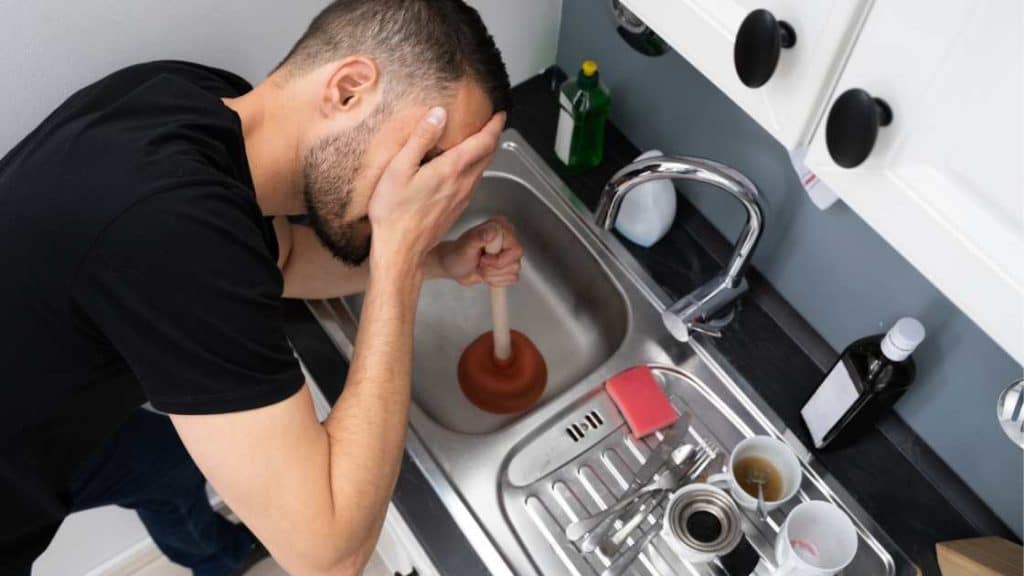“Does Paint Clog Drains?”
Yes, paint can clog drains. Its chemical components harden, leading to blockages.
Dealing with home renovations can often lead to surprising issues like clogged drains. Disposing of leftover paint down the sink seems like a quick clean-up solution, but it’s a major faux pas for your plumbing.
The paint contains a variety of chemicals that aren’t just harmful to the environment but are also notorious for creating stubborn blockages in pipes.
As a liquid, paint may seem harmless, but as it dries, it solidifies, adhering to the insides of your drain pipes. This can lead to reduced water flow and eventually a complete blockage, making it a necessity to avoid pouring any type of paint into your drain.
It’s essential to take preventative measures and dispose of paint properly to maintain a fully functional drainage system in your home.
Introduction To The Problem

Does paint clog drains? This question troubles many homeowners and DIY enthusiasts after a project. Paint and plumbing don’t mix well.
Unclogging a drain from paint is costly. Proper disposal of paint is essential to avoid plumbing issues. This post examines the impact of paint on plumbing systems and the properties of various paints.
Impact Of Paint On Plumbing
Paint contains chemicals that can damage plumbing systems. When paint dries out, it creates a solid mass that can block pipes. These blockages restrict water flow and can lead to leaks. Professional cleaning services might be needed to address these issues, leading to unexpected expenses.
Different Types Of Paint And Their Chemical Properties
| Type of Paint | Base | Drying Time | Chemical Properties |
|---|---|---|---|
| Latex Paint | Water | 1-2 hours | Washable, low VOC |
| Oil-Based Paint | Oil | 6-8 hours | High VOC, durable |
| Acrylic Paint | Water | 1-2 hours | Quick-drying, versatile |
Latex and acrylic paints are water-based and easier to clean while wet. But, once dry, they can form tough blockages. Oil-based paints have a longer drying time but are hazardous to plumbing due to the chemicals involved.
Composition Of Paint
Paint contains is key before considering pouring it down the drain. Paint consists of various chemicals and materials. Some components may harm plumbing systems. Let’s explore these materials.
Components That Make Up Paint
Paints have several ingredients. Each serves a specific function:
- Pigments give color and opacity.
- Binders hold pigments together and allow them to stick to a surface.
- Solvents keep paint in liquid form until application.
- Additives enhance certain paint features like durability.
Thickeners, stabilizers, and preservatives are also present. These compounds differ in water-based and oil-based paints.
Water-based Vs. Oil-based Paints: A Drainage Perspective
From a drainage view, the paint type matters. Water-based paints, also known as latex or acrylic, contain water as a solvent. They are easier on drains. Yet, they still pose risks.
Oil-based paints use petroleum products as solvents. They are more likely to clog drains than water-based paints. Disposal must be careful. The table below outlines the differences:
| Type of Paint | Solvent Base | Drainage Risk |
|---|---|---|
| Water-Based | Water | Lower Risk |
| Oil-Based | Petroleum Products | Higher Risk |
Never place oil-based paints into the drain. Find local waste guidelines for disposal. With water-based paints, seek out eco-friendly methods of disposal to mitigate plumbing issues.
How Drains Work

To know how drains function is key to knowing why certain substances, like paint, can cause issues. Drains are not just simple tubes that carry water away; they are carefully designed systems. These systems ensure water flows smoothly from your home to sewer systems or septic tanks.
Basic Principles Of Drainage Systems
Gravity plays the central role in a drainage system. Every drain uses a downward slope to move water and waste. Pipes, shaped in a ‘U’ or ‘J’ bend called a trap, keep odors from coming back up through the drain. This design also helps with pressure balance and preventing blockages.
- Downward Slopes
- Pipe Traps
- Ventilation Pipes
Common Vulnerabilities In Household Drainage
Household drains face common challenges.
| Issue | Cause |
|---|---|
| Built-Up Residue | Everyday materials like soap and hair |
| Blockages | Foreign objects, grease, or other thick substances |
Drains clog when wrong substances, like paint, are poured down. Over time, paint can build up, harden, and block pipes. This disrupts the flow of water and waste and can lead to costly repairs.
The Interplay Between Paint And Drains
When it comes to home maintenance, knowledge is power. Let’s talk about paint and your drains. Many homeowners may not consider the impact of paint disposal in their sinks. Yet, this common practice can lead to significant problems. Unraveling the mystery of how paint behaves in drains is critical.
Chemical Reactions Of Paint In The Drainage System
Chemical reactions from paint can wreak havoc on your pipes. Here’s what you need to know:
- Oil-based paints can react with substances in your pipes, forming stubborn residues.
- Latex paints might seem safe, but they can still contribute to build-up over time.
- Even water-soluble paints can change consistency, leading to issues.
Physical Blockages Caused By Paint
Paint can transform from liquid to solid, causing physical blockages. Let’s dig deeper:
| Paint Type | Blockage Risk |
|---|---|
| Oil-based | High – Hardens in pipes |
| Latex | Moderate – Thickens over time |
| Acrylic | Moderate to High – Forms globs |
The Risk Factors For Clogged Drains

Understanding why drains clog can prevent costly repairs. One culprit is paint. It might seem harmless, but it’s not. Does paint clog drains? Yes, it does. Recognizing key risk factors can safeguard your drainage system.
Volume And Frequency Of Paint Disposal
Larger volumes of paint increase clog risks. A tiny bit might not harm. But, regular rinsing of brushes or equipment does. These activities lead to buildup inside pipes over time.
- Frequent disposal affects drainage.
- Accumulation can happen with regular disposal.
- Minimize the habit to protect pipes.
Type Of Drainage System And Its Susceptibility
Not all drains are equal. Old or damaged drains are more prone to clogs. PVC pipes might handle paint better. But metal pipes will suffer sooner.
Assess your home’s or studio’s system. Know what you’re dealing with. Different systems mean different risks.
| Drain Type | Risk Level |
|---|---|
| Old Metal Pipes | High Risk |
| PVC Pipes | Medium Risk |
Remember, proper disposal matters. Consult local guidelines for safe practices. Keep those drains clear and functioning.
Environmental Concerns And Paint Disposal
Paint disposal matters a lot to our planet. When paint goes down the drain, it can clog and harm pipes. But the environment suffers too. Paint has chemicals. These chemicals can hurt wildlife and ecosystems. That’s why proper disposal of paint is necessary. Let’s explore eco-friendly ways to do this.
Eco-friendly Disposal Practices For Paint
Adopting green practices helps the Earth. There are steps to dispose of paint safely:
- Dry it out: If there’s a little paint left, let it dry. This makes it safer for disposal.
- Use kitty litter: Mix it with paint to solidify it. Once hard, it’s easier to throw away.
- Give it away: Someone might need it. Schools and theaters often seek paint donations.
- Recycle: Some places turn old paint into new products. Check local options.
Regulatory Guidelines For Paint Disposal
Laws keep our land safe. They tell us how to dispose of paint correctly. Always follow these rules:
- Check local laws: Rules differ by area. Find out what your town requires.
- Don’t pour down the drain: It’s illegal in many places. It can damage water treatment plants.
- Use drop-off sites: Many communities have special locations for paint disposal.
Remember, following environmental guidelines isn’t just good practice—it’s our responsibility. Let’s keep our water clean and our earth green.
Preventative Measures To Protect Drains
Preventative Measures to Protect Drains are vital when dealing with paint. Various paints not designed for drain disposal can clog and damage your plumbing system. This section explores practical steps to help you manage paint usage and storage, ensuring your drains remain clear and functioning properly.
Best Practices In Paint Usage And Storage
Adopting efficient paint handling routines is vital. Follow these tips to prevent accidental drain clogs:
- Use Paint Wisely: Only open what you need, avoiding excess.
- Recycle or Donate: Give surplus paint a second life.
- Proper Storage: Seal containers tightly and store in a cool, dry place.
- Dry Out: Let small amounts dry out before disposal.
Tools And Products To Minimize Drainage Risk
Equip yourself with the right tools and products. Here’s what to use:
| Tool/Product | Use |
|---|---|
| Paint Trays with Liners | Easy cleanup without washing paint down the drain. |
| Sealable Containers | Transport and store leftover paint securely. |
| Drop Cloths | Keep spills off the floor and away from the sink. |
| Solvent Wipes | Clean brushes without rinsing in the sink. |
By implementing these best practices and using the right tools, you can enjoy your painting project without the worry of clogged drains. Always dispose of paint responsibly and keep your plumbing healthy!
Professional Insights On Paint And Drainage

Understanding the relationship between paint and household drainage systems is critical for homeowners and professionals alike. Paint may seem harmless, but it can hide risks related to plumbing health.
Plumbing Expert Opinions On Paint Disposal
Plumbers agree: disposing of paint down the drain is a bad idea. This consensus comes from years of repairing clogged pipes. Paint contains chemicals and solids that can solidify in pipes, leading to costly damage.
- Latex paint dries out and shrinks, creating hard blockages.
- Oil-based paints coat the pipes, attracting other debris and causing build-up.
Safe paint disposal methods include:
| Method | Description |
|---|---|
| Dry out | Letting paint cans dry before disposal. |
| Hazardous waste drop-off | Local waste facilities often accept paints. |
| Recycle | Companies exist that can recycle unused paint. |
Case Studies: The Consequences Of Mismanagement
Real-life case studies show the damage caused by improper paint disposal. One homeowner faced extensive plumbing repairs after dumping latex paint down the sink. In another case, a community suffered environmental harm from paint in the sewage system affecting local waterways.
- Home sewer system replacement due to paint-induced clogging.
- Increased water purification costs for a small town’s facility.
- Negative impact on aquatic life caused by toxic paint chemicals.
Dealing With The Aftermath: Clog Removal
Once paint gets into your drains, clogs can form. These can stop water flow. Immediate clog removal becomes a must to protect your pipes. Quick action can prevent larger issues and save on expensive repairs. Explore some DIY solutions or consider professional help for stubborn clogs.
Diy Solutions For Unclogging Paint-filled Drains
Try these steps to unclog drains filled with paint:
- Assess the situation: See how bad the clog is. A little paint might be easy to clear.
- Wear protective gear: Put on gloves and goggles for safety before starting.
- Start simple: Use a plunger. It works well with minor clogs.
- Boiling water : Hot water can soften dried paint. Pour it down slowly.
- Vinegar and baking soda: Mix these for a natural cleaning fizz. Use it to break down the paint.
- Snake the drain : A plumbing snake can dislodge clogs from drains.
If simple methods fail, a paint solvent could work. Be sure to choose one that’s safe for pipes. Use it as directed and rinse well.
When To Call A Professional: Seeking Expert Help
Some clogs need professional help. Look for these signs:
- Continued slow drainage: If water still drains slowly after DIY methods, you might need a pro.
- Recurring clogs: Clogs that keep coming back may be deep in the system.
- Bad odors or sounds: Odd smells or noises can mean bigger blockages.
Professionals have the tools and expertise to safely remove tough clogs. They can prevent damage to your plumbing. Choosing expert help means getting your drains running smoothly without the guesswork.
Best Practices Recap
Welcome to the wrap-up of our comprehensive guide on drain safety concerning paint disposal. This segment recaps best practices and provides conclusive advice. Let’s avoid any paint-related drainage mishaps together.
Summary Of Key Points
- Paint can clog drains, causing significant plumbing issues.
- Types of paint behave differently in drains.
- Proper disposal is important for environmental safety.
Final Recommendations For Paint And Drain Maintenance
- Never pour paint down any drain.
- Use a paint can to collect leftovers.
- Let paint solidify before disposal.
- Contact local waste management for guidance.
- Regularly inspect and clean drains.
Follow these best practices to keep your drains functioning and the environment safe. Remember, proper paint disposal is the key to maintenance excellence.
Frequently Asked Questions Of Does Paint Clog Drains
Can Paint Clogs Damage Home Plumbing?
Yes, paint can cause significant damage to home plumbing. When poured down drains, paint can harden and create blockages that obstruct water flow, potentially leading to costly repairs.
How To Dispose Of Leftover Paint Properly?
Leftover paint should be taken to a local hazardous waste disposal facility. Alternatively, dry it out with kitty litter or a commercial paint hardener before disposing of it in the trash.
Will Latex Paint Clog My Sink Drain?
Latex paint can clog your sink drain if not disposed of correctly. It may appear liquid when poured, but once in the plumbing, it can dry and stick to pipes, causing clogs.
What Happens If Oil-based Paint Goes Down The Drain?
If oil-based paint goes down the drain, it can congeal and block pipes, disrupting the wastewater flow. It’s also harmful to the environment, so proper disposal is important.
Will Acrylic Paint Clog Drain?
No, acrylic paint should not be poured down the drain as it can solidify and potentially clog the pipes. It is advisable to dispose of acrylic paint properly by allowing it to dry and then disposing of it in the trash.
Conclusion
Wrapping up, it’s clear that paint and drains don’t mix. To maintain unblocked pipes, proper disposal methods for paint are necessary. Remember, safeguarding your plumbing from clogs protects both your home and the environment. Next time you’re done painting, think before you pour.
Choose sustainability—it’s the smart move.

